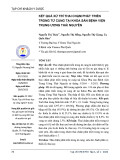
TNU Journal of Science and Technology
230(01): 302 - 308
http://jst.tnu.edu.vn 302 Email: jst@tnu.edu.vn
ANTIFUNGAL RESISTANCE OF CANDIDA SP. CAUSING VAGINITIS
DURING PREGNANCY
Quoc Ky Duyen*
Nguyen Tat Thanh University
ARTICLE INFO
ABSTRACT
Received:
13/8/2024
Vulvovaginal Candidiasis is a common endogenous fungal infection,
ranking second among the causes of vaginitis in women of reproductive
age. The infection rate is particularly higher during pregnancy, with
30% of cases compared to 20% in non-pregnant women. This study
aimed to determine the antifungal resistance rates of Candida species
causing vaginitis during pregnancy. To achieve study goal, we analyzed
88 clinical specimens that tested positive for Candida species from the
vaginal discharge of pregnant women diagnosed with vaginitis. The
samples were cultured and isolated on sabouraud chloramphenicol agar,
then identified using chrome agar Candida, combined with real-time
PCR techniques to determine the infection rate of Candida albicans.
Results showed that among the 88 clinical specimens, Candida
albicans accounted for 53.41% (n = 47), non-albicans Candida species
included Candida glabrata (37.5%; n = 33), Candida tropicalis
(2.17%; n = 2), Candida krusei (1.14%; n = 1), and other Candida
species (5.68%; n = 5). The antifungal resistance of Candida species
was assessed using the disc diffusion method, revealing resistance rates
of 92.05% for fluconazole, 86.36% for itraconazole, 39.77% for
miconazole, 25% for clotrimazole, and 100% sensitivity to nystatin.
Revised:
17/11/2024
Published:
18/11/2024
KEYWORDS
Vaginitis
Candida sp.
Pregnant women
Antifungal drugs
Candida albicans
TÌNH HÌNH KHÁNG THUỐC CỦA VI NẤM CANDIDA SP.
GÂY VIÊM ÂM ĐẠO TRONG THAI KỲ
Quốc Kỳ Duyên
Trường Đại học Nguyễn Tất Thành
THÔNG TIN BÀI BÁO
TÓM TẮT
Ngày nhận bài:
13/8/2024
Viêm âm đạo do nấm Candida sp. là một bệnh nhiễm nấm nội sinh
phổ biến, đứng thứ hai trong các nguyên nhân gây viêm âm đạo ở phụ
nữ trong độ tuổi sinh sản. Đặc biệt, trong thời kỳ mang thai, tỷ lệ
nhiễm cao hơn (30%) so với không mang thai (20%). Mục tiêu của
nghiên cứu là xác định tỷ lệ kháng thuốc của Candida sp. gây viêm âm
đạo trong thai kỳ. Để thực hiện, chúng tôi đã khảo sát 88 mẫu bệnh
phẩm dương tính với Candida sp. từ dịch âm đạo của các thai phụ bị
viêm âm đạo. Các mẫu bệnh phẩm được cấy và phân lập trên môi
trường sabouraud chloramphenicol agar, sau đó định danh bằng
chrome agar Candida, kết hợp với kỹ thuật realtime PCR để xác định
tỷ lệ Candida albicans. Kết quả cho thấy trong 88 mẫu bệnh phẩm,
Candida albicans chiếm 53,41%, trong khi Candida non-albicans bao
gồm Candida glabrata (37,5%), Candida tropicalis (2,17%), Candida
krusei (1,14%) và các loài khác (5,68%). Khả năng kháng thuốc của
Candida sp. được đánh giá bằng phương pháp khuếch tán đĩa kháng
sinh, với tỷ lệ kháng lần lượt là fluconazole (92,05%), itraconazole
(86,36%), miconazole (39,77%), clotrimazole (25%) và nystatin đặc
biệt nhạy cảm 100%.
Ngày hoàn thiện:
17/11/2024
Ngày đăng:
18/11/2024
TỪ KHÓA
Viêm âm đạo
Candida sp.
Phụ nữ mang thai
Thuốc kháng nấm
Candida albicans
DOI: https://doi.org/10.34238/tnu-jst.10930
Email: qkduyen@ntt.edu.vn








































